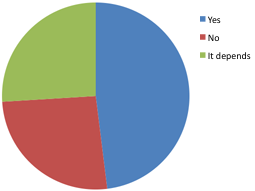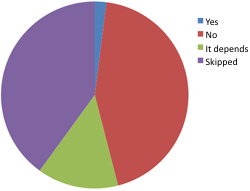Last Tuesday, I asked 'If you follow a museum on twitter, is it friendly or weird if it follows you back?' after calls from some quarters for #followavisitor #followamember or #MuseumsFollowYouBack days after followamuseum day on Twitter. The poll gathered 50 responses overall and I've presented an overview of the results here.
Question 2 was added in response to a suggestion from a respondent after 20 responses had already been given, so for this reason alone, the results should not be taken as anything other than an interesting indication of responses. I've shared the written responses to various questions, and provided a quick and dirty analysis of the results.
1. If you follow a museum on twitter, do you want it to follow you back?
 |
Yes 49% No 26.50% It depends 26.50% |
13 further comments were given for 'it depends':
- if they're conversational or broadcasting
- I hope they do, they don't have to.
- Depends on what the account is doing. If it's just sending out announcements, who cares if it follows you back? If they're actually using Twitter, and there's an actual person back there somewhere doing something interesting, I'd be pleased if they decided to follow me, like any other user.
- Of couirse I'd like it, but I understand if they don't due to over-following capacity!
- If the museum is going to engage w/ me then yes; if it's just to broadcast I'm on the fence
- I'm an art historian, so if an art museum started to follow me, I would be flattered! But if another kind of museum followed me, I would be slightly confused. So I think it would depend entirely on the profession of the person and if they use their account in a professional way
- If they start wanting to be my best bud, I'd probably get creeped out and block them.
- I wouldn't mind being followed, but not as a data point in a marketing database or to get impersonal spam.
- I don't think I really have a strong view either way.
- Why?
- If I've started a discussion with said museum through twitter
- Don't mind either way in most cases
- it has no material effect — I don't gain anything from it following me.
2. If you follow a museum on twitter, do you mind if it follows you back?
 |
Yes 2% No 44% It depends 14% Skipped 40% [See note above about the number of 'skipped' responses] |
7 further comments were given for 'it depends':
- I'd rather be able to look at who you follow to find other twitterers of interest. Can't do that if you follow thousands of people back. Be selective so we can look thru them.
- not unless my tweet is museum related
- It depends on whether I know who is behind the tweets. Being a museum professional, sometimes they are colleagues, and that's okay with me.
- I don't really care, but I think it's silly.
- I just don't see why they would, it doesn't help either of us
- See above :)
- I would prefer it to follow back, especially if it's relevant to my own areas of historical interest, but no one has to follow anyone they don't want to.
So it looks like you can't win – almost 50% of new followers expect you to follow them and 50% either don't, or only do under some circumstances. As you can see from the responses to questions 3 and 4 (below), the results have presumably been skewed as 50% of respondents have a close involvement with museums, and a whopping two-thirds have a professional or academic interest in social media. I'm using the free version of SurveyMonkey so can't easily split out the 'social media' or 'museum professional' responses from the rest to see if people who are neither have different views on reciprocal following.
The only way to get a sense of whether followers of your particular museum account expect to be followed back, or mind being followed back, may be to ask them directly.
Of the people who were able to answer question 2, a very small minority unequivocally minded being followed by a museum account, but 44% of those who answered don't mind if a museum account doesn't follow them back.
Another interesting question would have been 'is it friendly or weird if an organisation follows you after you mention them?' – if you do any more research into the issue, let me know.
Question 6 asked for 'Any other comments?'.
- Though I don't work in a museum, I work in or with museums. I think the main issue is that museums tweeting should have personality, you should feel it's a person (or group of people) that want to engage with you. I think if they follow me, it's more likely they will hear me and engage.
- By following and being followed by a museum it creates a sense of community (although of course I realize the museums won't have time to read all the tweets).
- I run a twitter account on behalf of a library, and think it's good manners to follow back someone who follows you (like returning a hello). I always try to reply to people who want to talk to us, but try not to butt into conversations that are *about* us, but which don't want us to reply to them (this can be tricky). As a user, by and large – I only want to talk to museums when I know the people doing the tweeting – and in New Zealand, I know most of these people anyway. Internationally, I do the same thing. Courtney Johnston, @auchmill, @nlnz
- I like when museums respond to my comments or @ replies, but I'm not as comfortable with them following me. Being responsive is different than following.
- Twiter has become one of the best sources for professional info & contacts @innova2
- It would be more useful for the museum to keep track of hashtags, etc.
- I want to communicate with people I follow, so following me back makes it easier. I don't expect them to read all/most of what I say, but it's nice…especially on my protected account (otherwise they never see the @)
- Museums rock!
- I don't really mind either way. I find it flattering if an institution wants to follow me. They must think I have something to say!
- I feel that museums have a great opp to get more individuals involved in history and the arts via social media – personally I follow a few and am always pleased to hear about new exhibits, events, etc.
- I work with museums, that's why I would like them to follow me back. I use Twitter for work, so I don't mind if they follow back. If I would talk to my friends over Twitter about private stuff maybe I WOULD mind….
- If a museum (or anyone) didn't follow back, I would probably unfollow after a while unless their tweets were really something special.
- I want people/institutions to follow me if they have genuine interest in my tweets – the same criteria I apply when choosing who to follow myself!
- The real question probably should have been (or maybe an additional question should have been): do you MIND if a museum you follow follows you back. Because really, I don't necessarily want them to, but I don't mind if they do. I have the power to block if need be.
- I think if the Museum was clear about WHY it was following me on twitter it would be less "stalkerish". In general I somewhat expect to be followed by those I am following. Although I am not sure if organizations (Museums) really need to follow individuals. I would imagine the Museum's staff would be overwhelmed with the number of completely unrelated tweets. What would be the advantage that couldn't be obtained better by simply searching twitter for key terms related to the museum, content, exhibit, etc? (Note: I do not work "in" a museum but have worked with over 6 museums to define and develop their websites and web marketing activities)
- I manage a twitter feed for a project at a science center. I follow people, organizations and businesses that are in the service area for the project (a watershed). I also follow other organizations that are working on similar issues (water quality).
- I think not following people back is poor Twitter etiquette. That is like saying to someone, "Listen to me! But I won't listen to you!"
- 1. Personally, I find follow bots mildly more insulting than not being followed back. 2. In my professional capacity tweeting for a museum, if someone @mentions us, I follow them (I consider it friendly). The fact that this could be done equally well (and more efficiently) by a bot disturbs me a bit.
- I tweet with an interest in culture, art, and museums in mind. It's more of a compliment for museums to follow back than a feeling of being stalked, as it shows interest in its reader's tweets.
- Leave the poor souls alone, they only want to know what's going on at your museum. I've blocked Museum of London (and I have every reason to trust them. Or not)
- How is it stalkerish…dumb survey
- Happy to be followed if it would help the museum understand more about its audience
Finally, the demographic questions (kept brief to keep the survey short)
3. Do you work, study or volunteer in a museum?
Yes 56%
No 44%
4. Do you work, study or volunteer in social media?
Yes 68%
No 32%
5. Where in the world are you?
| Countries | Total respondents |
| Australia | 2 |
| Belgium | 1 |
| Canada | 2 |
| Germany | 1 |
| Netherlands | 4 |
| New Zealand | 1 |
| Norway | 1 |
| Spain | 2 |
| Switzerland | 1 |
| UK | 17 |
| USA | 18 |